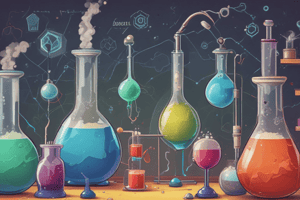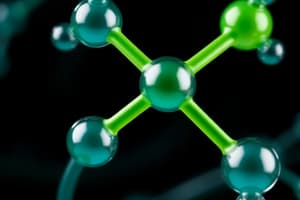Podcast
Questions and Answers
What is chemistry?
What is chemistry?
The study of matter and the changes it undergoes.
What is qualitative analysis?
What is qualitative analysis?
Consisting of general observations about the system.
What is quantitative analysis?
What is quantitative analysis?
Comprising of numbers obtained from various measurements of the system.
What is matter?
What is matter?
What is a mixture?
What is a mixture?
What is a homogeneous mixture?
What is a homogeneous mixture?
What is a heterogeneous mixture?
What is a heterogeneous mixture?
What is an element?
What is an element?
What is a compound?
What is a compound?
What is a physical property?
What is a physical property?
What is a chemical property?
What is a chemical property?
What is kelvin?
What is kelvin?
What is absolute zero?
What is absolute zero?
What is accuracy?
What is accuracy?
What is precision?
What is precision?
What are significant figures?
What are significant figures?
What is the law of definite proportions?
What is the law of definite proportions?
What is the law of conservation of mass?
What is the law of conservation of mass?
What is an atom?
What is an atom?
What is radiation?
What is radiation?
What is radioactivity?
What is radioactivity?
What is atomic number?
What is atomic number?
What is mass number?
What is mass number?
What are isotopes?
What are isotopes?
What is the periodic table?
What is the periodic table?
What are periods in the periodic table?
What are periods in the periodic table?
What are groups/families in the periodic table?
What are groups/families in the periodic table?
What are alkali metals?
What are alkali metals?
What are alkaline earth metals?
What are alkaline earth metals?
What are halogens?
What are halogens?
What are noble gases?
What are noble gases?
What is a molecule?
What is a molecule?
What is an ion?
What is an ion?
What is a cation?
What is a cation?
What is an anion?
What is an anion?
What are chemical formulas?
What are chemical formulas?
What is a molecular formula?
What is a molecular formula?
What is an empirical formula?
What is an empirical formula?
What is atomic mass?
What is atomic mass?
What is molecular mass?
What is molecular mass?
What is a mole (mol)?
What is a mole (mol)?
Flashcards are hidden until you start studying
Study Notes
Chemistry Basics
- Chemistry is defined as the study of matter and the changes it undergoes.
- Matter is anything that occupies space and has mass.
Types of Observations
- Qualitative observations involve general descriptions of a system.
- Quantitative observations are numerical data obtained from measurements.
Mixtures and Substances
- Mixtures combine two or more substances while retaining their distinct identities.
- A homogenous mixture has uniform composition throughout, whereas a heterogenous mixture does not.
- Elements cannot be separated into simpler substances via chemical means, while compounds consist of two or more elements combined in fixed proportions.
Properties of Matter
- Physical properties can be measured without altering the substance's identity.
- Chemical properties require a chemical change for observation.
Units of Measurement
- Kelvin (K) is the SI unit for temperature, with absolute zero defined as 0 K or -273.15 degrees Celsius.
Measurement Accuracy and Precision
- Accuracy refers to how close a measurement is to the true value.
- Precision indicates how consistently multiple measurements agree with each other.
- Significant figures are the meaningful digits present in a measured or calculated quantity.
Fundamental Laws
- The law of definite proportions states that samples of the same compound always have their elements in the same mass ratio.
- The law of conservation of mass asserts that matter cannot be created or destroyed.
Atomic Structure
- Atoms are the basic units of elements that can engage in chemical combinations.
- Radiation is the transmission of energy through space in wave form; radioactivity refers to the spontaneous emission of particles or radiation.
- The atomic number defines the number of protons in an atom, while the mass number is the total number of protons and neutrons.
Isotopes and the Periodic Table
- Isotopes are atoms with the same atomic number but different mass numbers.
- The periodic table categorizes elements with similar properties; periods are horizontal rows, and groups (families) are vertical columns.
Groups of Elements
- Alkali metals are found in group 1A, alkaline earth metals in group 2A, halogens in group 7A, and noble gases in group 8A.
Molecules and Ions
- Molecules are formed when atoms lose or gain electrons.
- Ions are charged particles that result from this electron transfer; cations have a positive charge, while anions carry a negative charge.
Chemical Representation
- Chemical formulas express the composition of molecules and ionic compounds using chemical symbols.
- Molecular formulas indicate the exact number of atoms for each element, while empirical formulas show the simplest whole number ratio of atom types.
Mass Concepts
- Atomic mass reflects the mass of an atom in atomic mass units (amu) or grams.
- Molecular mass is the sum of the atomic masses within a molecule and is treated similarly to atomic mass.
Mole Concept
- A mole (mol) represents a quantity of substance containing the same number of particles as there are atoms in 12 grams of carbon-12, serving as a convenient counting method in chemistry.
Studying That Suits You
Use AI to generate personalized quizzes and flashcards to suit your learning preferences.




